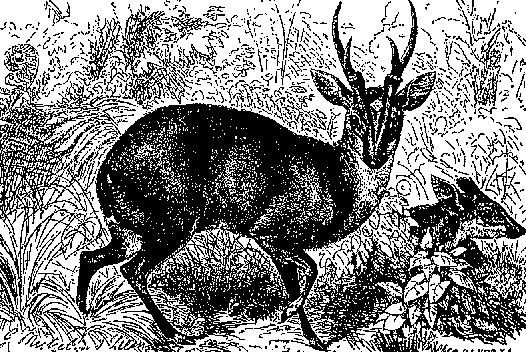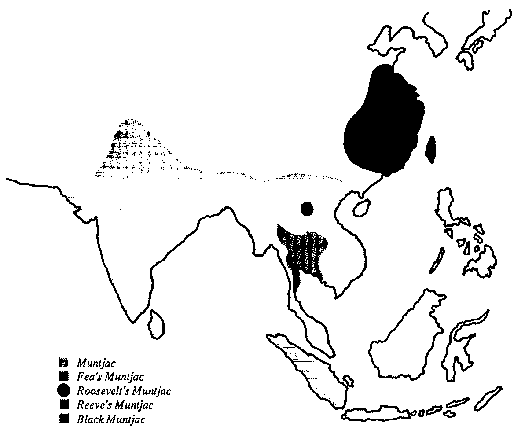
| Microlivestock - Little-Known Small Animals with a Promising Economic Future (b17mie) source ref: b17mie.htm |
| Part V : Deer and Antelope |
 |
|
27 Muntjac

FIGURE
Muntjac, or barking deer (Muntiacus species), are among the most widespread but least known of all Asian animals.1 They are almost the size of an average dog and they bark, but they are true deer. These little animals adapt well to captivity and have been introduced to zoos and wildlife collections throughout the world.
In recent years one species, the Reeves' muntjac, has become established in England, and a few specimens have settled into semicaptivity - staying behind fences, accepting human presence, and even eating out of people's hands. In Sarawak, villagers have also been known to keep muntjac, feeding them a diet of rice with some leafy matter occasionally added.2 Such experiences show that these small, shy deer can be calm and adaptable. It also shows that they can be raised on practical, artificial diets and that they are not strictly browsers. This creates the possibility (admittedly highly speculative) that they might make future microlivestock.
Muntjac produce lean, palatable venison and perhaps could be farmed on an organized basis. They are native to severe environments where heat, humidity, and endemic diseases make raising conventional livestock difficult. In future, given research, muntjac might become widespread contributors to Asian economic development. The lessons learned in captive breeding could also be important for conserving endangered muntjac species.
One species, the Indian muntjac, has an incredibly low chromosome number (2n=7 in males; 2n=6 in females), which makes them particularly promising candidates for mammalian genetic studies. This species has regularly bred well in both zoos and research institutions.
APPEARANCE AND SIZE
Muntjac are small and slender. Reeves' muntjac, the smallest, has a shoulder height of 45-60 cm. Fully grown, it weighs less than 20 kg; commonly it is merely 10-12 kg. The Java subspecies of the Indian muntjac is the biggest, with a shoulder height of 58 cm and a mature weight of 43 kg.
Antlers on the males usually include a main prong as well as a much shorter brow tine. Even the main prong is no larger than a finger, but its pointed tip is hooked and must be treated with caution. There are also two tusklike canine teeth that protrude from the mouth. These have sharp points and a knifelike posterior edge, capable of cutting to the bone a person's finger or another muntjac's rump.
Coloration varies from deep brown to yellowish or greyish brown with cream or whitish markings, depending on the species.
DISTRIBUTION
Muntjac are native to a vast region from eastern China to Nepal, India, Sri Lanka, and Indonesia.
Almost a century ago, Indian and Reeves' muntjac were introduced to a deer park in southeast England. Some escaped, and (as noted) the Reeves' muntjac has adapted, spread, and settled down to life in the countryside.
STATUS
Of the five muntjac species, the Reeves' and the Indian are well known and in no danger. For instance, recent estimates of annual game production have shown that there are about 650,000 Reeves' muntjac in China. The other three are threatened with extinction. Black, Roosevelt's, and Fea's muntjacs are virtually untried in captivity, but the success of raising Reeves' muntjac in English country gardens suggests that perhaps their populations could be saved through captive breeding.
HABITAT AND ENVIRONMENT
In their native habitats, these small deer are usually found in dense vegetation on hilly ranges at elevations up to at least 3,000 m.3

The native ranges of the various muntjacs
BIOLOGY
Muntjac seem to be primarily browsers. However, in captivity they eat fresh grass, alfalfa hay, and feed pellets. They also readily eat root crops such as potatoes, carrots, and parsnips. They are "concentrate selectors," preferring foods low in fiber and rich in protein and nutrients. Captive specimens reportedly need; a supply of cut browse.
Breeding may occur year-round, but in practice it is synchronized with certain seasons. The first conception can occur as early as 6 months of age. One, occasionally two, young are born after a gestation of about 200 days. They weigh around I kg at birth, and the fawns usually remain hidden until they can move about with the mother. The females mate within a few days of giving birth. Life spans up to 16 years have been recorded.
As noted, the Indian muntjac is a species of great cytogenetic interest. It has the lowest diploid chromosome numbers yet found in a mammal.4 The large, easily distinguishable chromosomes are a great advantage in tissue culture, and many laboratories now have muntjac cell lines. The karyotypes of the different species' chromosomes are very different; the Indian and Reeves' muntjac can hybridize, but the offspring are infertile.
BEHAVIOR
Muntjac are dainty and have a captivating charm. Always on the alert, they are active both day and night. Often they will bark for an hour or more, but typically they bark for only a minute or two. When panicked, captive muntjac may rush into fences or walls. They can easily leap barriers 1.5 m high.
Males are highly territorial and defend their territories vigorously. Adult females also inhabit a specific territory, which they defend against strange individuals.
Males mark the ground at intervals by lowering the head and rubbing the frontal glands on the ground and by scraping their hooves against the ground. They mark trees by scraping the bark with the lower incisors and rubbing the base of their antlers.
USES
In Asia, muntjac are hunted for meat, skins, and antlers.
HUSBANDRY
Muntjac thrive and, at least under ideal conditions, breed freely in captivity. However, they may stop breeding if they are crowded.
In England, zoos and private collections keep as many as six muntjac in an area of 40 x 20 m. Plenty of cover is provided for the animals to hide in. Fences almost 2 m high are used. (Lower fences are reportedly adequate where there is no risk of the deer being panicked by dogs or people.)
ADVANTAGES
Like other deer, muntjac produce extremely lean meat.
They seem to be healthy animals. In Britain, wild and captive muntjac have few gastrointestinal worms, and ectoparasites such as ticks and lice are not a problem.
MUNTJAC
In England, far from Asia's forests and mountains, the Reeves' muntjac is the subject of a peculiar chapter in the otherwise unhappy history of introduced species. Charmed by the deer's odd characteristics, the British have welcomed its invasion into gardens around the country. Now, there are tens of thousands of muntjacs on the loose, and some people have even adopted them as pets.
Although other alien species have wreaked havoc on native plants and animals, muntjacs appear to be a merciful exception. At least over the short term, muntjacs "have proven to be an almost innocuous asset to the countryside. They give pleasure to thousands and pain to few. Eating mostly ivy, grass, leaves, and prickly bushes, they rarely feed in one place long enough to do much damage except to an occasional suburban garden."
Life for many muntjacs is made soft by homeowners who find the deer's large, dewy eyes and tiny antlers irresistible. The kind-hearted suburbanites put out salt licks, water, and kitchen scraps, and they built snug little shelters against the cold north wind. "All our adult deer will take food from the hand," says Walter Buckingham, who has kept muntjacs for five years in his garden in the county of
Hertfordshire, just north of London.
The adaptable immigrant is colonizing new areas so rapidly, say biologists, that soon there may be more in England than in Asia. "In time," predicts muntjac-researcher Oliver Dansie (pictured opposite), "it may eventually establish itself as our most widely distributed deer species."
LIMITATIONS
In the wild these animals are not gregarious and are generally found alone or in pairs. Because of their strong territorial instincts, large males may not be able to be kept together without fighting. The upper canine teeth can inflict serious wounds. Some females are intolerant of each other as well.
Muntjac are fragile; they cannot be held by the legs, for example.
Some infectious diseases may prove to be of epizootic importance: foot-and-mouth disease, mucosal disease, epizootic hemorrhagic disease, rinderpest, and tuberculosis (all three types). This may be a problem, especially when people are raising the animals by hand.
RESEARCH AND CONSERVATION NEEDS
To ensure a better understanding of their potential as microlivestock, muntjac deserve research and recognition from animal scientists and conservationists from Nepal to China. The English experience shows how populations of the endangered species might be built up. At present, however, none are receiving any husbandry research; only the two most common species can generally be found in zoos.
These animals deserve investigation into physiology, reproductive requirements, fertility, nutrition (for example, food preferences, feeding strategies, and food utilization), growth, adaptability and environmental tolerance, diseases, management, social structure, and selection for calm temperament.